Charles N. and Harriett Ellis Lanphere
Charles and Harriet were married the 25th of December, 1895. The couple studied abroad for several years then returned to Potsdam and made their home on Pierrepont Avenue. Mr. Lanphere lectured and taught the history of music and pianoforte. He was renowned as a lecturer on music, principally on the music of the Bible.
 He spent years studying music and musical instruments of the early world and was considered an authority, reproducing his own extensive collection of instruments representing instruments of the Bible, Egypt, Chaldea, Assyria and Palestine. He reconstructed these instruments using images depicted in rock sculptures, tomb paintings, coins and other archeological items. Not satisfied with reproducing them, he also learned to play them. The original collection was destroyed in a fire but he was able to reproduce most of them a second time.
He spent years studying music and musical instruments of the early world and was considered an authority, reproducing his own extensive collection of instruments representing instruments of the Bible, Egypt, Chaldea, Assyria and Palestine. He reconstructed these instruments using images depicted in rock sculptures, tomb paintings, coins and other archeological items. Not satisfied with reproducing them, he also learned to play them. The original collection was destroyed in a fire but he was able to reproduce most of them a second time.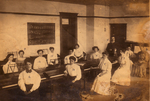 In 1931 Charles Lanphere joined the Crane faculty as a piano teacher. Charles N. Lanphere died May 23rd, 1940 and his collection was donated to the Normal School by Harriet Lanphere. Harriet Lovis Ellis Lanphere died the 21st of October, 1953.
In 1931 Charles Lanphere joined the Crane faculty as a piano teacher. Charles N. Lanphere died May 23rd, 1940 and his collection was donated to the Normal School by Harriet Lanphere. Harriet Lovis Ellis Lanphere died the 21st of October, 1953.Mr. Lanphere was fascinated by the development of music from it's very beginnings. He traveled to Europe and studied in London, Paris and Dresden. He wrote two famous lectures, "The First Ten Thousand Years of Music" and "Music of the Bible". The instruments in this exhibition are reproductions made by Mr. Lanphere around 1900 to illustrate his lectures.
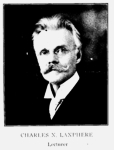
The instruments in this exhibit were donated to the Potsdam Public Museum by Dr. Robert Washburn with the exception of the violin, which was donated by Helen Hosmer.
Update: March 2014
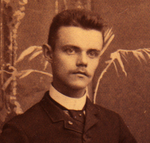
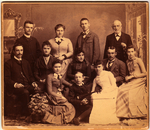 The museum has discovered a very early image of Mr. Lanphere in which he is
identified as the organist in a photograph of the Baptist Choir in June
1889. Since he was born in June 1869, the image is a portrait of him at
age 20. He would have been in his second year as a student in the Music
Conservatory of the Potsdam Normal School directly across the street
from the church.
The museum has discovered a very early image of Mr. Lanphere in which he is
identified as the organist in a photograph of the Baptist Choir in June
1889. Since he was born in June 1869, the image is a portrait of him at
age 20. He would have been in his second year as a student in the Music
Conservatory of the Potsdam Normal School directly across the street
from the church. The First Baptisit Church was constructed in 1853, and demolished by fire in 1971.
MUSICAL INSTRUMENTS OF ANCIENT TIMES: The Charles Lanphere Collection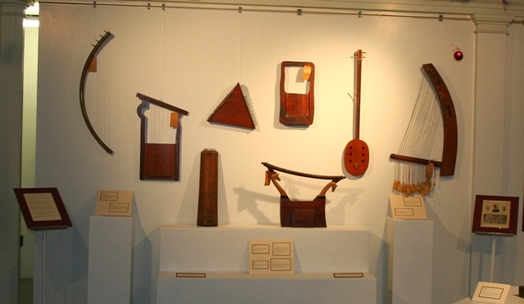
Seen here from left to right:
Bowharp- Egyptian, 3500 B.C.
Kinnor - Egypto/Isreali, 1200 B.C.
Psaltry - European Middle Ages
Kinnor - Small Hebrew Harp, 1800 B.C.
Nefre - Egyptian Lute, c. 1900
Lefre - Egyptian Horsehead Lire
Kinnor - copied from a Jewish coin 160 B.C.
Dr. Lanphere built a collection of early instruments using ancient texts and coins and architectural detail from tombs and temples for inspiration. He returned to Potsdam in the 1930s accepting a piano teaching position and became dear friends with Helen Hosmer. These instruments were used for many years as teaching tools at the Crane School of Music. They have been donated to the museum by Dr. and Mrs. Robert Washburn.
Psaltery (c.1900)
From the middle ages, this wooden triangular-shaped instrument is a descendant of a Hebrew instrument.
Kinnor c.1900 Image2 (label)
Small Hebrew Harp labeled "Pictured on Egyptian tomb of Beni Hassan, 1800 B.C., in the hands of a Semitic in Egypt, conjectured to be a brother of Joseph. This is the oldest form of several stringed harps represented in Egyptian reliefs. The Kinnor of later periods appears in several forms".
Harp c.1900
Wooden stringed instrument, No strings.
Lyre c.1900 Image2 Image3 Image4 Image5 (Tag)
Egyptian Horse-head Lyre labeled "Egyptian Horse-head Lyre. It was carried on the shoulder of the player. A funeral instrument, often pictured in tombs in connection with obsequies of the dead. Original specimens have been found in tombs".
Harp c.1900 Image2 Image3
Bow Harp with four strings labeled "Egyptian Bow-Harp four strings. Older than the Nofre - (3500 B.C. although no pictured until later date). Not far removed from the hunting bow, man's first harp. No sound box".
Kinnor (c.1900) Image2 Image3 Image4 (label)
Egypto-Israeli stringed instrument labeled "A common form in Egypt around 1200 B.C. It is conjectured (not proven) that this form was brought out of Egypt by the Israelities at the time of the Exodus, and was played by them in Palestine - perhaps even in the Temple Service".
Psanterin c.1900 Image2
Assyrian stringed instrument labeled "Psanterin - Assyrian. Copied from a bas relief in the British Museum. Often pictured on Assyrian monuments, and always in the hands of a Monarch or High Priest. An instrument of royalty. Its strings were beaten with a small mallet, or plectrum. It was without doubt, play in the feast of Belteshazzar".
Hebrew Nebel c.1900 Image2 Image3 Image4 (tag)
Large Harp, has gold fabric tassels labeled "Nebel - large harp. The most impressive harp of the Hebrews. Believed to have been the chief instrument accompanying the Psalms in the Temple Service in Jerusalem. Mentioned many times in the Bible. Its identity is almost positively established".
Kinnor c.1900
Wood, painted gold labeled "Kinnor - small harp, one of several forms. This harp is copied from a design on a Jewish coin struck 160 B.C. The Jewish Talmud declares that King David hung above his bed a Kinnor of gold, that night winds passing over its strings made soft aeolian music. The association is only conjectural".
Psaltery c.1900 Image2 Image3
Stringed instrument from the Middle Ages labeled "In this form it was brought from Palestine by the Crusaders on their return from the Holy Wars. It became the most popular stringed instrument in Europe; and it the direct forerunner of our piano".
Nofre c.1900 Image2 Image3
Three-string Lute, strings missing labeled "The oldest sting instrument represented pictorially. It is employed as a hieroglyphic character on an Egyptian tomb 5600 years ago meaning 'good'. Its three strings symbolize spring, summer and winter".
Crotala c.1900
Egyptian percussion instrument, clapper. Painted yellow with painted head at top. "Employed in religious worship, dance, and in war. Played by the soldier musicians at the wrecking of Salem, on the ruins of which reared the city of Jerusalem".
Rattle c.1900
Percussion instrument with wooden handle, and brass loop with rings. "Menaaneim - a jingling rattle. Incorrectly rendered in the King James translation as 'Cornet'. It was employed extensively by the Egyptians to drive away evil spirits. Cleopatra employed them by the thousands in her armies to protect her soldiers from the satanic influences".
Whistle c.1900 Image2
Egyptian, made of wood.
Harmonica c.1900 Image2
Chinese, bronze (?) wind instrument. "Chinese Harmonica. Tones produced by drawing the breath and uncovering the finger holes. From Hong Kong."
Drum c.1900 Image2 Image3
"Talking Drum", from India. "Sweeping the drum head with his thumb, the player produces pitch variants, imitative of inflections of the voice".
Tamborine c.1900 Image2 Image3
Troph-Timbrel. Egyptian-Hebreaic. Top has black design, small bells on the outer ridge, three bells inside. "Copied from Egptian fresco 1500 B.C.Timbrel played by Miriam at the Deliverance from the host of the Pharo at the Red Sea. Always played by a woman as accompaniment of a dance and song. Divine command had not yet prohibited pictorial designs".
Sebaca c.1900 Image2 Image3 (label)
A triangular Harp
Egyptian Shoulder Harp c.1900 Image2 Image3 Image4
"A funeral instrument. It is pictured on monuments from 1500 B.C. This form was often placed beside the mummy in the tomb. Several originals have been found. It was always carried on the shoulder of the player".
Nebel c.1900 Image2 Image3 Image4 (label)
"Instrument of ten strings. Nebel Asor, Assyrian Harp. Referred to in the Psalms as 'An instrument of Ten Strings'. Often pictured on Assyrian monuments, and always in the hands of a monarch of High Priest, it was evidently a favorite of royal entertainments. Its identity, as the instrument mentioned in the Psalms, is not positively established".
Tambura c.1900 Image2 Image3 (label)
Large instrument with a base of parchment covered wood. "Pentatonic Air on the Tambura, parchment covered lute."
Toph c.1900 Image2 Image3 (tag)
Hand drum, bronze color with Blue edge (Ribbon replica handbags). "Toph-hand drum. Egypto-Israelitish. Often pictured in Egyptian sculpture and painting, not clearly differentiated from the 'Timbrel' or 'Tambourin' as both forms are know to have been using in Egypt and probably in Palestine. It seems probable that the Toph was played by men, as this form is always pictured in the hands of men - the Timbrel form in the hands of women".
Lecture Box c.1925 Image2 Image3
Made and used by Charles Lanphere as he lectured on the beginnings of music and the biblical instruments on display. Edited by Lanphere and containing hand drawn illustrations of the musical instruments and musical notations.
Charles Lanphere was brought up on a farm where hard work and spiritual instruction were the focus. The music at church moved the small child and he begged his father to buy him a violin. When he was told that music was to be kept in church by his father, he decided in secret to built his own violin out of a wooden cigar box and some barn boards. He used the hair of their horse to make the hunting bow. When his father discovered the violin in the rafters of the barn he asked Charles if he could play it and play it he did! His father then decided to encourage his musical talents and bought him a proper violin.
Charles Lanphere kept the handmade violin for a lifetime and gave it to Helen Hosmer as a gift. She donated it to the museum and it is the very instrument that Hilary looks at!
CHARLES A. LANPHERE TIMELINE
Born: near Copenhagen, Jefferson, NY 15 JUN 1869
Education:
- Hawthorne Piano School
- Potsdam Normal School Music Conservatory, 1888-1891 (2 ˝ yrs.)
- New England Conservatory of Music, Boston (grad.)
- Studied at museums in London, ENG
- Paris, FR
- Dresden, GER
- Studied with Herman Schultz, Chopin expert, Dresden, GER (for several months)
Professional: Lecturer and director, Virgil Piano School, Chicago, IL
- Official lecturer for International Society of Pianoforte Players and Teachers:
- Berlin, GER
- London, ENG
- Lecturer at Cooperative Educational Union, Boston, MA
- Head of piano dept. of Conservatory of Maine, Portland
- Director, Northwest Conservatory of Music, Minneapolis, MN
- Taught piano and music, James Millican University, Decatur, IL; 1904-1912
- Performed at Boston Public Library, 29 MAR 1925
- Taught music history & piano, Potsdam State Normal School, Crane Department of Music; 1931-1940 (res. 38 Pierrepont Ave.)
Buried: Bayside Cemetery, Potsdam, NY replica watches
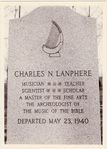
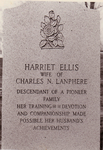
Additional Images
1934 SUNY Potsdam Pioneer Year Book (NNYLN)
1935 SUNY Potsdam Pioneer Year Book (NNYLN)
1937 SUNY Potsdam Pioneer Year Book (NNYLN)
1939 SUNY Potsdam Pioneer Year Book (NNYLN)
1935 SUNY Potsdam Pioneer Year Book (NNYLN)
1937 SUNY Potsdam Pioneer Year Book (NNYLN)
1939 SUNY Potsdam Pioneer Year Book (NNYLN)

